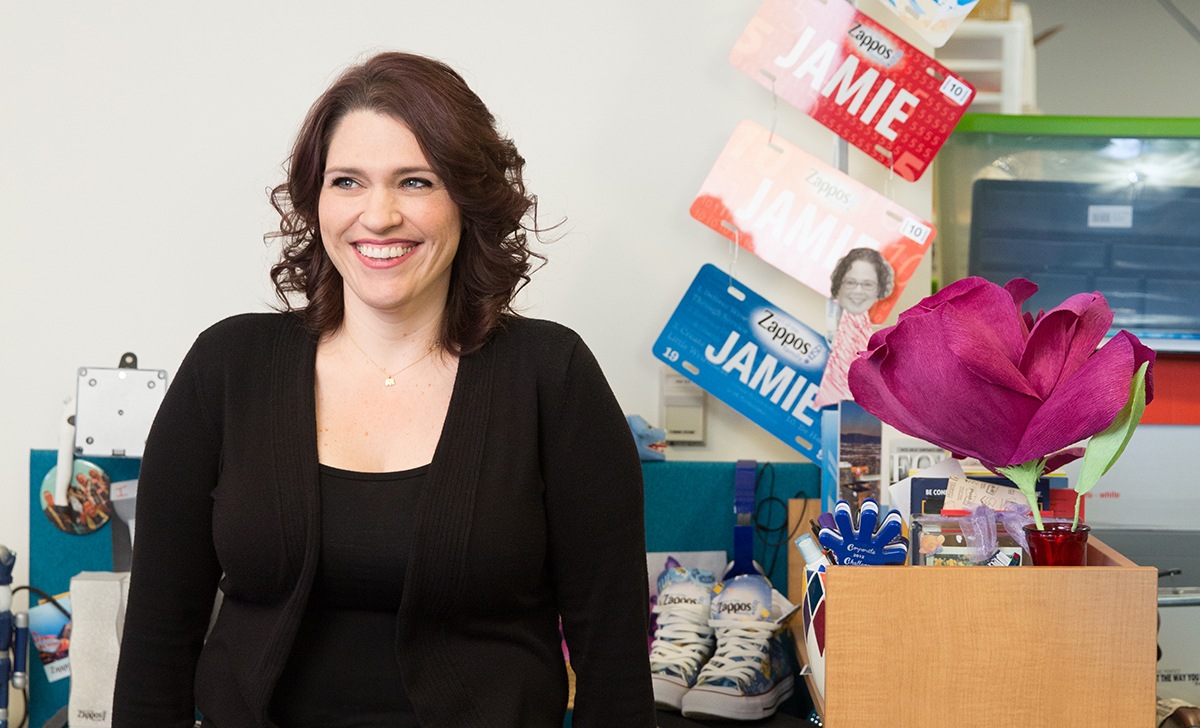Being intentional about your company’s core values from day one can help to build a solid foundation to guide behavior as your organization grows; few leaders understand this as well as Zappos’ Tony Hsieh.
Zappos has long been an example of the power that company culture has on behavior and business performance. But what’s behind the curtain? What is the team at Zappos doing, specifically, that is driving their admirable levels of employee engagement and retention? 2016 was Zappos’ lowest turnover rate since its founding more than 18 years ago — and I wanted to know the how and the why.
To find out, I asked Jamie Naughton, Zappos’ Chief of Staff, to share her insights.

For Jamie, it all starts with her personal journey to Zappos which, she believes, is a testament to the way the organization is run. Having initially worked as an external staffing professional to Zappos, Jamie realized early on that it was a place she’d like to be. “It was more than 12 years ago when I first knew I wanted to be a part of the Zappos team,” Naughton shares. “The people I would send to work there always came back telling me how much Zappos cared about their culture and how great it was to work in an environment like that.”
Today, Naughton focuses her efforts on building myriad efficiencies within the organization for its 1,500+ employees.
When Tony Hsieh took over as CEO at Zappos, he knew he wanted to create an organization where people genuinely enjoyed working. By paying close attention to every single new hire, he was able to ensure his vision became reality. Several years later, the team at Zappos formalized what they held near and dear by creating Zappos’ 10 Core Values. Doing so helped provide a clearly articulated beacon for members of the team to evolve all of their processes and ensure their unique culture was able to scale as the company grew.
Getting clear and explicit about the company’s core values gave all members of the organization a common language and understanding of what “right” looks like at Zappos. “There isn’t a day that goes by where there isn’t a mention of our Core Values in some way,” says Naughton. “They allow everyone to easily prioritize what’s really most important.”
Because the process was so intentional, the results weren’t all that surprising. “We knew as we were building the company that focusing on culture was paramount,” Naughton adds. “In order to provide amazing service to our customers, we knew we had to provide that same level of service to our employees and vendors.”
To fully embed this value of service in all members of the team, each and every new employee, regardless of position, attends a full four-week call center training program, including dozens of hours on the phones supporting live customers. And to reinforce this message, every employee spends a minimum of ten hours during the holidays on the phones as well.
Surprisingly, these mandatory trainings have helped with innovation. “When our developers started going through this training, and were forced to use the systems and tools they created for our call center, they began noticing opportunities for improvement. So, the developers would finish their training and then go back to their usual desks and start building efficiencies in our tools to make it easier for call center employees to do their jobs.”
Zappos’ Three Keys to Employee Engagement and Retention
Zappos’ focus on engaging and retaining great talent revolves around a continuous focus on three things:
Culture.
The culture at Zappos is grounded in their Core Values. But simply articulating values, as many organizations do, is not nearly enough. True value is created when they are actually integrated into everything the organization does. Naughton advises, “Don’t let your values become a dusty plaque on a wall, somewhere near the front desk. Talk about them and, more importantly, live by them. Make decisions with the values in mind.”
Passion.
“We want our employees to find meaning in their work. Our company is self-organized, which means employees aren’t tied to one area of the company,” says Naughton. Team members are given the freedom to flex and support in ways that are outside of their “box,” which keeps Zappos innovative, efficient and purposeful.
Ownership.
Zappos leadership gives employees the tools to do their jobs while owning their work, setting them up for success by stepping out of the way. Naughton provides an example of how this plays out in their day-to-day operations: “In our call center, every representative has all the tools they need to make customers happy. They don’t need to ask a supervisor for permission to override policies or compensate for lapses in service.” Giving employees ownership and empowerment to make decisions is not to be understated here. Zappos believes that the people doing the work and servicing customers every day are the ones best suited to make the decisions necessary to take care of those customers.
While this approach may not work in all organizations, parts of this example are generalizable. The prime being that, whatever you value and whatever culture you feel will drive the results you want in your business, you must be intentional. Taking the time to be clear about who you are and how you do things and understanding when and how to evolve in order to drive results is what matters.
Zappos has designed a foundation that elicits the customer-focused behaviors its leaders feel are critical to its success, and the organization continues to reinforce these values and ways of working continuously in every aspect of their activities.
What might you do in your organizations to help bring some intention to what you value and how you need to work together in order to succeed?
This article originally appeared on Forbes.

